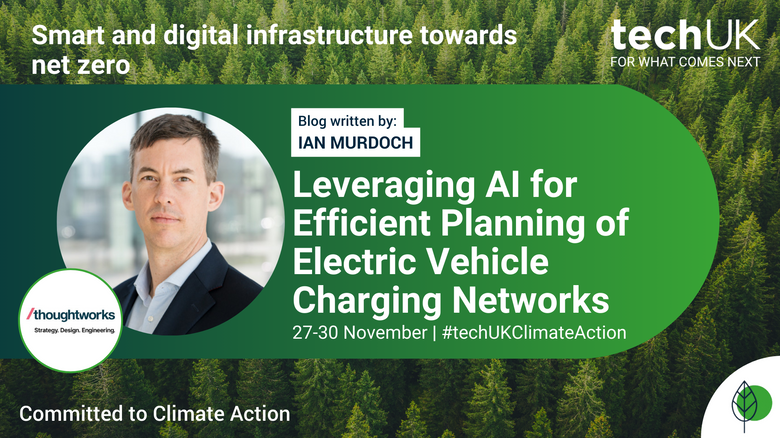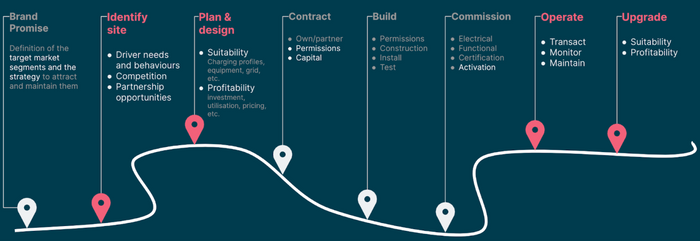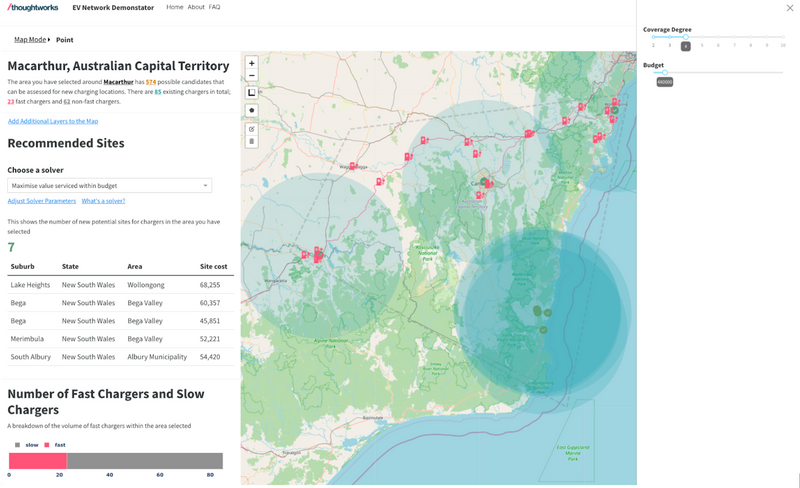Leveraging AI for Efficient Planning of Electric Vehicle Charging Networks (Guest blog from Thoughtworks)
Guest blog by Ian Murdoch, Principal Executive Advisor at Thoughtworks. Part of techUK's Climate Action at COP28 Campaign Week 2023.

The world is witnessing a monumental shift towards electric vehicles (EVs) as a sustainable and eco-friendly mode of transportation. With the corresponding surging demand for EV charging infrastructure, the market is witnessing a proliferation of competitors, intensifying the competition for prime locations.
Identifying and evaluating future charging site locations, however, is a time and labor-intensive process, exacerbating the challenges. Moreover, the high capital requirements and long-term investment commitments involved in building and operating charging sites raise concerns about the risk of capital misallocation, potentially resulting in an overabundance of high-power chargers in unsuitable locations.
Here, Thoughtworks explores how AI can reshape the planning of these networks, streamlining the process and optimizing for user needs while maximizing return on investment.
The race of finding a needle in a haystack
Currently the identification and qualification of a site is a complex and human-dependent task. Evaluating each individual site can take up to a week, and depending on who is doing the work - and where the work is performed - can cost between 20 - 50kEUR. With so many factors to consider, it’s not easy to get it right.

The solution: Using data and AI Augmented to optimize the design of an EV charging network
Thoughtworks has harnessed AI to develop a proof of concept that significantly reduces the time required for site evaluation, turning a process that could take up to a week into a matter of minutes.
It consists of a live application that allows users to draw over an area of the map they are interested in to design the network, producing data layers that include points of interest, existing charger locations and potential sites for new chargers within that region. With the ability to select from different solvers, the app provides optimal solutions that focus on different aspects including budget, charger density, population density and POI coverage.

AI-powered tools have the potential to simplify and expedite the process, and offer several benefits:
Customization: Allows for customization based on the brand promise of stakeholders. For example, it can prioritize locations near family-friendly cafes or destinations suitable for long-distance travelers.
Automation: Several steps in the planning process, including generating CAD drawings for planning permission documents, can be automated, significantly reducing costs and time.
Profitability assessment: The AI solution can provide a detailed evaluation of a site's profitability, taking into account various parameters. This facilitates quick decision-making.
Scalability: As the demand for EV charging infrastructure continues to rise, AI can efficiently scale up the planning process to assess millions of potential charging locations across the world.
Real-time updates: AI can adapt to changing circumstances, helping stakeholders make informed decisions based on the latest data and market trends.
Sustainable growth: With AI's help, the EV charging network can grow sustainably and efficiently by considering factors like traffic patterns and network saturation, ensuring that new charging stations complement existing infrastructure.
Harness the Power of AI for Your EV Charging Network
The transition to electric mobility is accelerating, making efficient EV charging networks vital. The conventional planning approach is slow, manual, and costly. With AI-driven solutions, the planning process becomes automated, efficient, and data-centric, ensuring sustainable growth and an enhanced user experience.
Thoughtworks is ready to help our clients embrace the power of AI in EV charging network planning and optimize their business strategy for the electric vehicle era.
techUK - Committed to Climate Action
Visit our Climate Action Hub to learn more or to register for regular updates.
By 2030, digital technology can cut global emissions by 15%. Cloud computing, 5G, AI and IoT have the potential to support dramatic reductions in carbon emissions in sectors such as transport, agriculture, and manufacturing. techUK is working to foster the right policy framework and leadership so we can all play our part. For more information on how techUK can support you, please visit our Climate Action Hub and click ‘contact us’.



